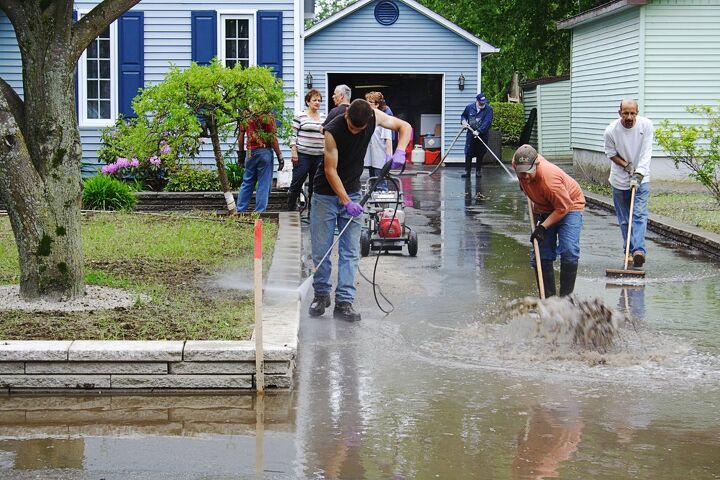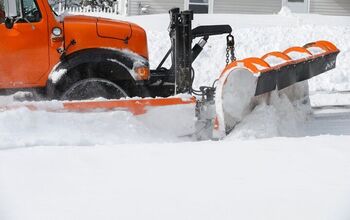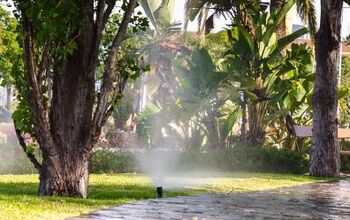How To Stop Your Driveway From Flooding

Not only is driveway flooding inconvenient, but it’s also potentially dangerous. Luckily, there are many ways to prevent driveway flooding, but it can be expensive. So, what are the best ways to stop your driveway from flooding?
The best way to stop your driveway from flooding is to install a French drain. French drains carry water away from your driveway through perforated pipes. Culvert pipes, catch basins, swales, and trench drains can also remove floodwater from your driveway. Standing water can seep through foundation cracks and threaten your home’s structure.
The easiest way to prevent driveway flooding is to dig small trenches along your driveway. However, that method isn’t always effective, depending on the driveway’s slope. Follow along as we explore how to stop your driveway from flooding.
How To Prevent Driveway Flooding
It takes hard work to stop a driveway from flooding, but it’s a worthy investment. Most methods involve excavation, which is best done by contractors. The best ways to prevent driveway flooding include:
1. Install A French Drain
A French drain makes it easy to stop your driveway from flooding. It directs water from your driveway via perforated pipes that carry water away. Depending on the location, the French drain can send water into your landscape or a catch basin.
It costs an average of $5,000 to install a French drain, but it can cost as little as $2,700. Ideally, you should hire a professional for this job unless you have excavation experience. French drains are the most effective way to stop your driveway from flooding, but there are other great options.
2. Put In A Catch Basin
Install a catch basin if you live in an area with frequent rain. Catch basins effectively hold water, so it doesn’t pool in your driveway. Professionals typically install catch basins in the landscape to store water until the rain stops.
However, you can also install a catch basin in your driveway. Keep in mind that this can be more labor-intensive because you must cut through concrete. It costs an average of $3,500 to install a driveway catch basin, but it can cost up to $5,000 for each basin you install.
You may need a large, 22'x22' catch basin if your driveway and landscape are large. Otherwise, a 12'x12' catch basin is typically enough for a small driveway.
3. Install Permeable Pavers
Permeable pavers are visually appealing, easy to install, and can protect your home and driveway from water. These effective pavers absorb water, so it doesn’t roll away and pool. They are also incredible during winter because ice is less likely to form on them.
The pavers are made of porous concrete, but clay brick is also effective. You can put crushed aggregate between the pavers to further protect your driveway from flooding. Another benefit of permeable pavers is that you can find them in nearly any color.
You can take this opportunity to complement your home’s appearance and increase curb appeal. This is a fairly easy DIY project, but it can be quite time-consuming. It costs an average of $8 per square foot to install permeable pavers, but it can cost up to $12 per square foot.
4. Use A Culvert Pipe
Culvert pipes may not look great, but they can prevent your driveway from flooding. These big pipes can’t typically go at the bottom of a sloped driveway. That’s because they run underneath driveways and need a spot to release water.
You can install a culvert pipe at the bottom of your driveway if you have enough land on either side. This is an intense installation job because it involves excavation, which is tricky and expensive. It costs an average of $4,400 to install a culvert pipe.
However, it can cost up to $8,000 depending on who you hire and how much excavation is required. This is worth the cost because driveway flooding can lead to severe erosion and even foundation damage.
5. Deflect Water With A Swale
A swale is a sunken ditch that can direct water away from your driveway. While you can make a swale, it’s best to hire a landscaper because it can be intense. This typically requires a bulldozer or backhoe of some sort, which you can rent, but it can be dangerous to use.
You can’t simply dig a swale out, as you’d have to move so much dirt. It’s worth the cost and effort to build a swale, as it sends water to a runoff point. Some people even use swales in conjunction with French drains to maximize results.
Not only do swales prevent your driveway from flooding, but they also look great. You can expect to spend up to $15 per linear foot to install a swale because it is labor-intensive.
6. Install A Trench Drain
Trench drains are quite common for sloped driveways. These simple, grated drains catch water, but they also catch lots of debris. Because of that, they can get clogged easily if you don’t clean them regularly.
Ideally, you should clean the trench drain at least once per month to ensure your driveway doesn’t flood. It’s easy if you remove the grates and pull out debris like leaves, pebbles, and dirt. It’s best to hire a professional to install a trench drain because it is quite difficult.
However, you can do it if you have a circular saw and are experienced in concrete work and PVC pipes. The PVC pipe will direct the water away from your driveway as long as the grates aren’t clogged. Trench drains typically only run 6” deep, so you won’t have to cut too far.
7. Dig Small Trenches
You don’t necessarily need to rent an excavator to stop your driveway from flooding. Depending on the slope, you may be able to dig small trenches on either side of your driveway to prevent flooding. This isn’t as effective as installing a French drain or catch basin, but it works.
That said, this isn’t the best option if you live in a climate with frequent heavy rainfall. Dig a trench that measures 5’ to 8’ feet on either side of your driveway. Make sure to dig the trenches in the spots where you typically find standing water.
You may eventually need to dig these trenches again, depending on how well they hold up. Mud can sometimes slide back into the trenches, which makes them shallower.
Is A Flooded Driveway Dangerous?
A flooded driveway can be dangerous if it affects the foundation of your home. Pooled water can seep into your foundation, especially if it’s already damaged. This can severely worsen the foundation damage, and that poses a structural threat.
Standing water can also damage the driveway itself. Water can cause driveway erosion, which can make it crack and crumble eventually. It’s hard and expensive to fix a damaged driveway, and you could spend $3,100 or more.
Call a contractor right away if you notice driveway erosion. Foundation damage costs $2,000 to $8,000, but it can be much pricier in extreme cases.
Summing It Up
Install a French drain or catch basin to stop your driveway from flooding. Both options effectively steer water away from your driveway, so it doesn’t pool. Swales, trench drains, and culvert pipes also help remove standing water. Otherwise, install porous permeable pavers so water doesn’t erode your driveway.
Related Guides:

Nick Durante is a professional writer with a primary focus on home improvement. When he is not writing about home improvement or taking on projects around the house, he likes to read and create art. He is always looking towards the newest trends in home improvement.
More by Nick Durante



























